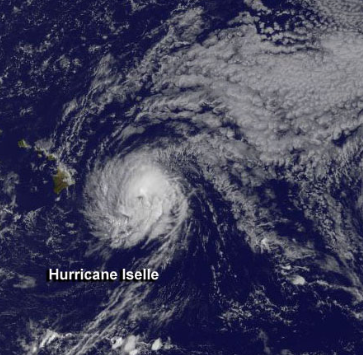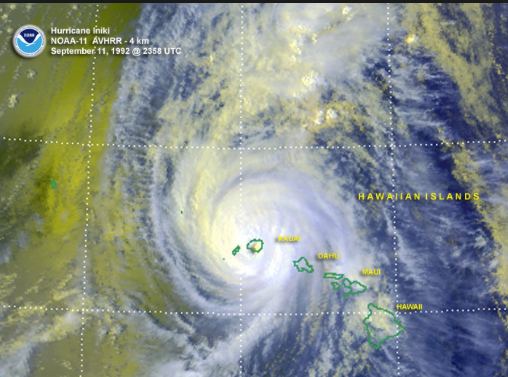 In the wake of the fierce hurricanes with tragic consequences that have beset Houston and Florida in recent days, we must note that in the Pacific Ocean, the hurricane season is not over until November 30th.. Hawaii Island has had it’s share of hurricane scares and hits.
In the wake of the fierce hurricanes with tragic consequences that have beset Houston and Florida in recent days, we must note that in the Pacific Ocean, the hurricane season is not over until November 30th.. Hawaii Island has had it’s share of hurricane scares and hits.
In 1992, Hurricane Iniki sideswiped our island causing extensive damage along the Kona coast and just a few years ago, Hurricane Iselle hit the Eastern section of Hawaii island on August 2, 2014. Several airlines cancelled flights servicing the entire Hawaiian Island chain. Upon making landfall, Iselle brought torrential rainfall and caused strong winds which resulted in widespread power outages and downed trees. The storm caused heavy crop damage, estimated at $66 million (2014 USD, including 60% of the state’s papaya that was lost.
Of course, Kailua-Kona can proudly count many near misses and dissipation events that would seem that we are relatively immune to Mother Nature’s nasty effects. However, times are changing and being complacent should not be a way of life when a hurricane threat approaches.
New residents may wonder why water and toilet paper, yes, toilet paper are the first to disappear from store shelves when a hurricane warning goes out. Fresh water my not be available if winds or storm surge knock out the pumping stations/well machinery and the waste water treatment plant. As evidenced in Houston last week, when hundreds of thousands of residents were left without fresh drinking water, it is a crucial commodity in an emergency, especially on an island where we can’t just go siphon water from a lake or reservoir ourselves. Toilet paper (along with every other packaged good that makes life easier for us all in Hawaii) comes into ports on ships. Ships won’t come into Hawaiian waters under a hurricane threat. Threats and the actual storm could take as long as 3-4 days with nothing getting restocked in any store on the island, or even longer. The Hawaii Hurricane Center said be prepared for up to 14 days without services. Think about that. Here’s why:
 “The reason we’re increasing the recommendation to 14 days (previously 7) is based on the documented experience from other states and jurisdictions that have gone through similar disasters. If our residents are resilient, able to take care of themselves during an event, we can focus more on restoring critical infrastructure such as our ports, roads and power plants,” said Vern Miyagi, the HI-EMA Administrator. “Depending on the damage, it will likely take 2 weeks or longer for the critical infrastructure to be fully or partially operational.”
“The reason we’re increasing the recommendation to 14 days (previously 7) is based on the documented experience from other states and jurisdictions that have gone through similar disasters. If our residents are resilient, able to take care of themselves during an event, we can focus more on restoring critical infrastructure such as our ports, roads and power plants,” said Vern Miyagi, the HI-EMA Administrator. “Depending on the damage, it will likely take 2 weeks or longer for the critical infrastructure to be fully or partially operational.”
Here is the recommendations from the Hawaii Hurricane Center so you can be prepared now and not wait until thousands of people go rushing to the store at the same time.
Put together an emergency kit now and maintain it throughout the hurricane season to avoid long lines at stores and gas stations shortly before and after a potential tropical storm event. Keep them for the entire season and plan to partially consume and replenish to keep the items fresh. Get ahead of the game. Don’t try to fill your tanks with gas the day before the hurricane arrives.
HI-EMA also recommends residents and visitors take the following actions to prepare for any possible hurricane or tropical cyclone.
- Talk with family members and develop a clear understanding what you will do if a hurricane or tropical storm threatens. Prepare an action plan that includes details such as whether your family plans to shelter in place or evacuate.
- Know if your home is in an inundation zone, flood zone, or susceptible to high winds and other hazards. Know if your home is retrofitted with hurricane resistant clips or straps.
- Stay tuned to local media and their websites/applications regarding weather updates.
- Sign up for local notification systems (i.e., Civil Defense, HNL Info, Blackboard CTY).
- Get to know your neighbors and community so you can help each other.
- Download the “Ready Hawaii: app from the iTunes or Google Play! store. This app can aid in your emergency planning and will list shelters if they are opened for evacuation.
- Walk your property and check for potential flood threats. Clear your gutters and other drainage systems. Remove and secure loose items. Keep your car gas tanks filled.
- Prepare your pets by checking or purchasing a carrier and other preparedness items. A pet carrier is necessary for your pet’s safety if you plan to evacuate to a pet-friendly shelter. Don’t forget 14 days of food and water for your furry family members.
- Set aside an emergency supply of any needed medication and keep a copy of your prescriptions in case you run out of medication after a disaster.
- Secure your important documents in protective containers.
- Build an emergency kit – now.
The LUVA Real Estate team sends our thoughts and prayers to the thousands of residents who have lost their homes and way of life in the British Virgin Islands and the mainland. Our Aloha goes out to all. Stay safe and be prepared.